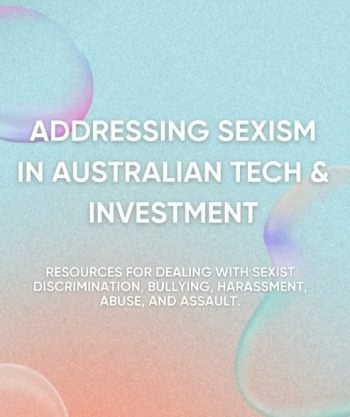As someone who has always been a minority in an industry, it was, embarrassingly, only in my 30s that I genuinely began to properly clock how tilted the stage is.
Up until then, I was that person who said cringey things like “I genuinely don’t think I have ever experienced sexism or harassment”. Lol.
Oh, the mental gymnastics we perform in order to convince ourselves our paths are due to merit or completely in our control.
Obviously once I became a little more educated, experienced, and critically analysed the data and experiences, I formed a different, more accurate view. And a bit like how when someone you know buys a particular car, you notice them everywhere, for the best part of the last two decades I’ve noticed the overt, casual and covert sexism at play all around us.
I’ve also been horrified at the stories that have emerged of harassment, bullying, and abuse. I made a decision several years ago to fight against it institutionally and personally, whenever I saw it.
As we embarked on this project late last year and put out a public request for input, we had many in the ecosystem who proactively reached out and asked ‘how can we help?”.
However in the 40-plus conversations we had with different ecosystem participants it also became clear that many weren’t aware of ways in which they were responsible or contributing to the problem, how they could address the issue, or of the approaches groups had already embarked upon and open sourced.
Some just didn’t know where to start.
It’s was also clear, as we heard story after story of poor behaviour, complaints and trauma that went unaddressed or dimissed, and peoples careers in tech thwarted as a result, that many companies in the tech and startup ecosystem are small and have limited resources, time and training to deal with some of these issues.
And so, this collation of resources provided by the ecosystem is what it says on the box — an open source collection of different approaches participants in our ecosystem have offered to help address the issue of sexism, harassment and abuse in our industry.
This collection of resources are merely tools and approaches, which are only as good as their use and enforcement, but we hope this provides some assistance to get those who need it, moving in the right direction.
It can be downloaded at this link here.
Please share it widely if you think this is something the industry can benefit from.
If you have a resource or an approach that you would like to include in this dynamic document, please let us know — you can email me at elaine[at]humanvc.co. We would love to add to it to showcase different approaches.
A big thanks to everyone who contributed and shared their stories both on the record and anonymously, they all help to inform. Hannah and I are so grateful.
The following is an excerpt from the introduction of the resource doc which explains in a little more detail why this is needed.
— — — — — — — — — — — — — — — — — — — — — — — — — — — — — — — — — — — — — —
Why is this collection of resources needed
Report after report and news story after news story, have outlined in detail the sexism plaguing the Australian technology ecosystem. But the issues highlighted therein are demonstrably worse for women of colour, LGBTQI women, women with a disability, or any woman at the intersection of one of more additional forms of disadvantage.
Men who also fit any of the above categories also suffer disadvantage comparative to men who don’t as do gender non-confirming people.
And when you look at the issues for marginalised people,they appear to sit in two distinct buckets.
The “gaps” bucket: In the one bucket is the multitude of ways marginalised founders are not being supported at equal levels to teheir non-marginalised counterparts. This bucket contains issues such as funding gaps, leadership gaps, STEM participation gaps, advancement gaps, pay and superannuation gaps and many others.
The “disrespect/trauma” bucket: In the other bucket, are issues that are a little more sinister. In this bucket are incidences of sexual harassment or assault; belittlement and bullying; overt and benevolent sexism, racism, and homophobia; discrimination against mothers, meritless underestimating of ability; and more.
These may seem like entirely separate buckets, but if we look closely we can see that the “disrespect/trauma bucket” contributes heavily to creating the ‘gaps” bucket. For instance we know that sexism contributes to salary and superannuation gaps, we know that meritless understimation of ability contributes to advancement and leadership gaps. These gaps emerged as a direct result of sexist thinking, attitudes and ideas that fill the disrespect bucket and translate to sexist actions and behaviours broadly.
These sexist thoughts and actions can be enacted by people of all genders, cultural backgrounds, roles and walks of life. However the data shows that in the majority of cases these acts are committed by people not belonging to the aforementioned classes of disadvantage, against those who do.
So why does it matter?
Stamping out disadvantage is not just the right thing to do. There are many tangible ways this inequality is hurting our ecosystem and Australia as a whole.
The womens economic gender equality taskforce late last year shared that the cost “In the crudest terms, $128 billion is the value to the Australian economy that can be realised by purposefully removing the persistent and pervasive barriers to women’s full and equal participation in economic activity,” Chair Sam Mostyn said.
One full of systemic issues that no indidivual can be held accountable for, and the other full of terrible actions that no-one is personally guilty of.
Startup ecosystem efforts to date
The reports of harassment and sexism in the startup ecosystem is despite efforts and attention to the issue from key players over many years, and broader efforts from the corporate landscape to stamp out such practices.
However, unlike some of the well resourced companies within the corporate landscape the startup ecosystem consists mostly of small to medium businesses with tight budgets, living with financial runways measured in months. Moreover, these companies are often led by people with limited training on how to create am environment that is both inclusive and productive.
It became clear when talking to various participants that many werent aware of ways in which they were responsible, could address the issue, or of the approaches groups had open sourced.
So, we sought to crowdsource different approaches, different players in the ecosystem have taken, to provide this as a living document of options for companies to read, adopt or discuss.
This is not a endorsement nor is it an assessment of what might be best practice, but rather a collection of resources you can access and identify what might work for you or your organisation to meet you where you are.




















Trending
Daily startup news and insights, delivered to your inbox.